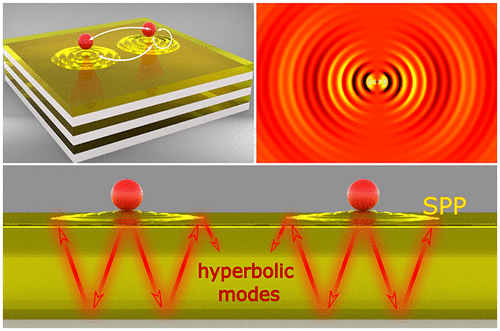当前位置:
X-MOL 学术
›
ACS Photonics
›
论文详情
Our official English website, www.x-mol.net, welcomes your
feedback! (Note: you will need to create a separate account there.)
Nanoscale Tunable Optical Binding Mediated by Hyperbolic Metamaterials
ACS Photonics ( IF 6.5 ) Pub Date : 2020-01-27 , DOI: 10.1021/acsphotonics.9b01378 Natalia A. Kostina 1 , Denis A. Kislov 1 , Aliaksandra N. Ivinskaya 1 , Alexey Proskurin 1 , Dmitrii N. Redka 2 , Andrey Novitsky 3 , Pavel Ginzburg 4, 5, 6 , Alexander S. Shalin 1, 7
ACS Photonics ( IF 6.5 ) Pub Date : 2020-01-27 , DOI: 10.1021/acsphotonics.9b01378 Natalia A. Kostina 1 , Denis A. Kislov 1 , Aliaksandra N. Ivinskaya 1 , Alexey Proskurin 1 , Dmitrii N. Redka 2 , Andrey Novitsky 3 , Pavel Ginzburg 4, 5, 6 , Alexander S. Shalin 1, 7
Affiliation

|
Carefully designed nanostructures can inspire a new type of optomechanical interactions and allow surpassing limitations set by classical diffractive optical elements. Apart from strong near-field localization, a nanostructured environment allows controlling scattering channels and might tailor many-body interactions. Here we investigate an effect of optical binding, where several particles demonstrate a collective mechanical behavior of bunching together in a light field. In contrast to classical binding, where separation distances between particles are diffraction limited, an auxiliary hyperbolic metasurface is shown here to break this barrier by introducing several controllable near-field interaction channels. Strong material dispersion of the hyperbolic metamaterial along with high spatial confinement of optical modes, which it supports, allows achieving superior tuning capabilities and efficient control over binding distances on the nanoscale. In addition, a careful choice of the metamaterial slab’s thickness enables decreasing optical binding distances by orders of magnitude compared to free space scenarios due to the multiple reflections of volumetric modes from the substrate. Auxiliary tunable metamaterials, which allow controlling collective optomechanical interactions on the nanoscale, open a venue for new investigations including collective nanofluidic interactions, triggered biochemical reactions, and many others.
中文翻译:

双曲超材料介导的纳米级可调光学结合。
精心设计的纳米结构可以激发新型的光机械相互作用,并允许超越经典衍射光学元件所设定的限制。除了强大的近场定位能力之外,纳米结构环境还可以控制散射通道,并可以调整多体相互作用。在这里,我们研究了光学结合的作用,其中几个粒子表现出在光场中聚集在一起的集体机械行为。与经典绑定不同,在经典绑定中,粒子之间的分隔距离受到衍射限制,此处显示了一个辅助双曲线超曲面通过引入几个可控的近场相互作用通道来打破此障碍。双曲线超材料的强大材料分散性以及它所支持的光学模式的高空间限制,可以实现卓越的调节功能,并可以有效控制纳米级的结合距离。此外,由于空间模式的多次反射,通过仔细选择超材料平板的厚度,与自由空间相比,可使光学结合距离减少几个数量级。辅助可调超材料允许在纳米级上控制集体的光机械相互作用,为包括集体的纳米流体相互作用,触发的生化反应等许多新的研究打开了场所。与自由空间方案相比,精心选择超颖材料平板的厚度可以使光学结合距离减少数个数量级,这是由于体积模式从基材的多次反射所致。辅助可调超材料允许在纳米级上控制集体的光机械相互作用,为包括集体的纳米流体相互作用,触发的生化反应等许多新的研究打开了场所。与自由空间方案相比,精心选择超颖材料平板的厚度可以使光学结合距离减少数个数量级,这是由于体积模式从基材的多次反射所致。辅助可调超材料允许在纳米级上控制集体的光机械相互作用,为包括集体的纳米流体相互作用,触发的生化反应等许多新的研究打开了场所。
更新日期:2020-01-27
中文翻译:

双曲超材料介导的纳米级可调光学结合。
精心设计的纳米结构可以激发新型的光机械相互作用,并允许超越经典衍射光学元件所设定的限制。除了强大的近场定位能力之外,纳米结构环境还可以控制散射通道,并可以调整多体相互作用。在这里,我们研究了光学结合的作用,其中几个粒子表现出在光场中聚集在一起的集体机械行为。与经典绑定不同,在经典绑定中,粒子之间的分隔距离受到衍射限制,此处显示了一个辅助双曲线超曲面通过引入几个可控的近场相互作用通道来打破此障碍。双曲线超材料的强大材料分散性以及它所支持的光学模式的高空间限制,可以实现卓越的调节功能,并可以有效控制纳米级的结合距离。此外,由于空间模式的多次反射,通过仔细选择超材料平板的厚度,与自由空间相比,可使光学结合距离减少几个数量级。辅助可调超材料允许在纳米级上控制集体的光机械相互作用,为包括集体的纳米流体相互作用,触发的生化反应等许多新的研究打开了场所。与自由空间方案相比,精心选择超颖材料平板的厚度可以使光学结合距离减少数个数量级,这是由于体积模式从基材的多次反射所致。辅助可调超材料允许在纳米级上控制集体的光机械相互作用,为包括集体的纳米流体相互作用,触发的生化反应等许多新的研究打开了场所。与自由空间方案相比,精心选择超颖材料平板的厚度可以使光学结合距离减少数个数量级,这是由于体积模式从基材的多次反射所致。辅助可调超材料允许在纳米级上控制集体的光机械相互作用,为包括集体的纳米流体相互作用,触发的生化反应等许多新的研究打开了场所。











































 京公网安备 11010802027423号
京公网安备 11010802027423号